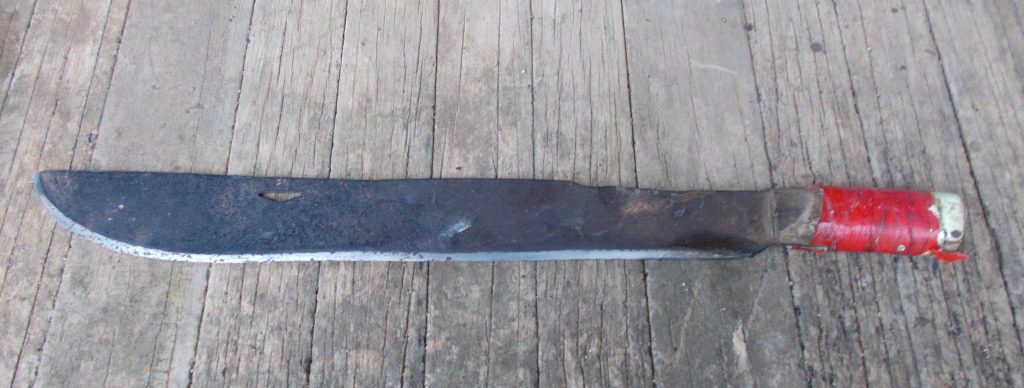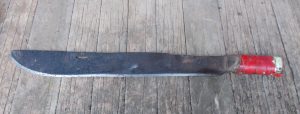
Decades ago I saw this old crosscut saw in a second hand shop for about $20 I suppose. Not your hardware store version version to use on a sawhorse with a piece of 4 by 2, this was nearly 2m long with big teeth and perpendicular handles at each end formerly used to fell big trees in the rainforest. So bought it. I can’t recall why, as it takes 2 people to operate and I had a huge chainsaw that has completely superseded this old saw. It is from the days where they used to cut notches in the tree about 3m from the ground to put ‘spring boards’ in to stand on to fell the tree above the buttress roots so common in rainforest trees. First they would cut a ‘bird’s mouth’ open cut with felling axes about one third to one quarter through the trunk, and then cut back to the bird’s mouth from the other side with the crosscut. A nice ‘hinge’ would be formed to control the direction of fall and to prevent any shattering of the timber.
Some time ago I went on a chainsaw course to get a ticket to be able to get a firewood licence. Creeping bureaucracy had caught up with me and deemed my 20 years of using a chainsaw and felling trees was was without value. Even more preposterously, two old fellers on the course had started their tree harvesting careers using springboard, axe and crosscut saw like mine, in the days when ox-trains hauled out the logs. They had imported and used the first ever chainsaw to reach the Tablelands when engines became light enough to lift off the ground ….just. What they didn’t know about felling a tree probably doesn’t exist but they needed a ticket too to continue what they had been doing all their lives. I overheard some learned talk between them and the instructor on such minutia as exactly where to hit the strap on a ‘leaney-tree back-strap cut’.
Meanwhile back at my saw, it sat around for a long time as an ornament until I had a bright idea how to use it. My little track in through the rainforest gradually becomes a little tunnel, and even that closes in to nothing unless the vegetation is cut back at intervals. I had been doing that with machete, axe and brush hook, but there is 2 km of track which means 4 km of hacking. Takes a couple of days of hard yakka. So I thought of vertically mounting the blade cantilevered off the side of my bull-bar and parallel to the direction of motion and then drive along at 20 km/h like a giant machete. I used a couple of old bit of railway line to cantilever but hit a snag. I couldn’t drill a hole in the 1.76 mm thick blade (I’ve just measured it). Not even on a pillar drill press with 12 speeds and HSS sharp drills. The bits just turned red-hot and hardly made a dent. The hardest steel I have ever come across. I had to cut small slots with and angle grinder for the bolt holes. Blade mounted! If this works, it will be biggest jump in productivity since the invention of the wheelbarrow I thought. It worked! You beaut! as I did a steady 20 km/h down one side of the track. For about 1 km until I hit a log hidden by the foliage and the blade shattered. Didn’t bend, didn’t tear, just shattered with every piece still flat. I sorrowfully picked up the pieces and limped home.
There my defeat rested until I lost my machete in the rainforest. Easily done with both handle and blade a dull brown. Now I tape my tools in glaring red. I went to the hardware store where they have heaps of them because this area has Australia’s highest vegetation densities and growth rates. I picked one up and didn’t like the dull look of the blade, and when I flicked it with a fingernail it gave a short dull ‘thock’ sound. Putty metal, I would never get a decent edge on that thing. All the hardware stores had the same thing. I don’t think the manufacturers in Shenzhou had ever tried using one. I went home in despair and sulked. Ping!! an idea came to me that ping was the sound I wanted. Although it was years since I had failed to drill holes in the old saw blade, I hadn’t throw the bits away and was pretty sure where I could get the ping sound. I got a long scrap and sure enough got a nice clear musical ping. I cut out a machete shape with an angle grinder and formed a crude edge then went to a fine belt on the belt sander and finished off the edge with a hand stone. The handle was a short bit of branch split down the middle and glued and wrapped with a thin strip of aluminium. On one side adjacent to the blade I cut a bevel for my thumb so it wouldn’t slip out of my hand when wet. On test it was even better than I had expected.

best machete in Oz
Just a lazy swing would cut through thin or soft stuff and a more vigourous blow would cut through a sapling the size of a banana with one blow. I learnt to sharpen it with an increasingly finer edge as it went from handle to tip. That is especially for vines. In the rainforest sometimes half the foliage mass in a tree would be vines and many are brought down struggling to support the mass of freeloading vines. Vines have little rigidity or mass and dance out of the way of a dull machete and just cannot be cut. So I use the finer edge near the tip for vines and a ‘wristy’ action for speed as in badminton. For the more substantial branches I use the less fine edge towards the handle with a more arm action as in tennis. That gets the momentum of the blade balanced on each side of where the blade contacts the branch and is known in engineering as the ‘center of percussion’ and leaves little reaction felt through the handle. In cricket the batters call it the ‘sweet spot’.
There:- that is more than you ever wanted to know about the construction and use of a machete. But if you have never had to use one for hours on end you can never know the bliss of using “The Best Machete In Australia’ as it ‘pings’ its way through thick stubborn rainforest. You can never know the proprietorial pride and satisfaction of the perfect tool. You may get some feeble idea from Crocodile Dundee with “That’s not a knife ……. (swish) THAT’s a knife” as he gazes admiringly at it’s blade, but that is just a dim reflection of the satisfaction a craftsman gets from his most treasured tools.
So that saw blade, probably made in the first couple of decades of the 20th century, has finally been reborn to its optimal use. It has been destroyed yet lives on. Silky oak and other timbers from the Tablelands now grace the Houses of Parliament in the (Dis)United Kingdom. Perhaps my saw was used in that construction. Perhaps it is only the knowledge of history that historians struggle to retain that is lost, but the elements inevitably live on.
I, like you Paul, am an Aichmomaniac. Always have, always will be. They fascinate me for their beauty, strength, design, uses and magnificence. Your story of the cross-saw is now written into History, no one can take those words from you. You are a Recycler Supremo who doesn’t give up – hence the title of this blog! I realise there was no better steel to make your machete, but to come to that conclusion was massive. For a mere $20 (I think it was a steal) you not only had an experience of a lifetime but a highly original journey towards making/using it for something you needed. May I ask “what happened to the two handles”? I presume they were timber…. You could not have known when you studied Engineering in your youth, how advantageous it would be many decades later. If it was mine (I already have one) I would put some leather thong through the handle to make a wrist-strap so you won’t ever lose The Best Machete in Australia”. But you obviously have kept it well. As for Historians, they make History themselves – they have a choice to write it from careful research and anecdotal evidence, as a true record (as near as it can be) – However, some are prejudiced and re-write it the way they want it to be. It pays to read as many accounts as one can, in one lifetime, and thereby , finally getting to the truth. Your history of the cross-saw is the truth, and that is history.